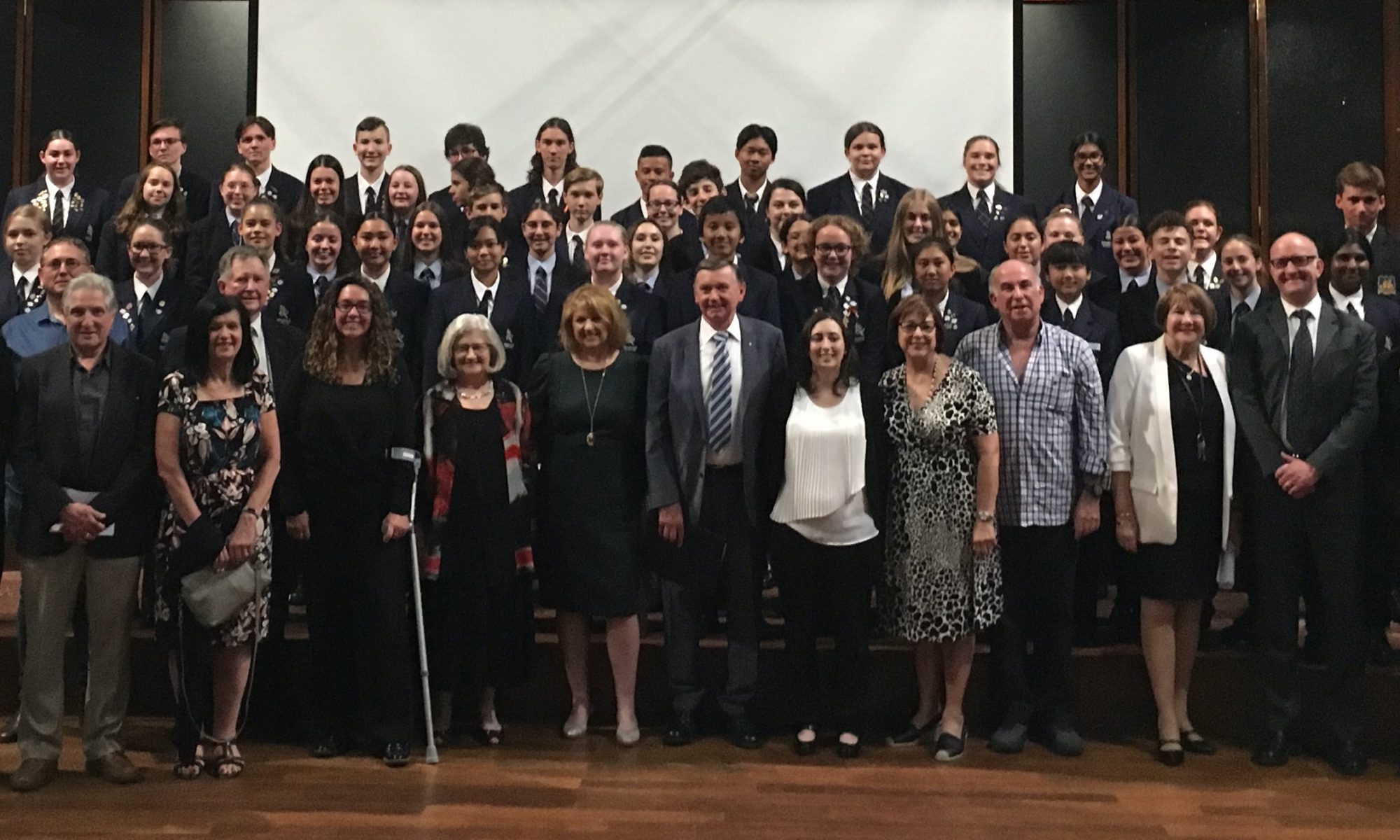

















 On ‘The Chronicle’ page we list the Pretoria Jewish Chronicles from Diane Wolfson.
On ‘The Chronicle’ page we list the Pretoria Jewish Chronicles from Diane Wolfson.
Please also contact Eli with any news to put on the site.

Source: kehilalinks.jewishgen.org/pretoria/Chronicle.html
Website: https://kehilalinks.jewishgen.org/pretoria/
Other KehilaLinks: https://elirab.me/kehila
https://blog.myheritage.com/2021/03/80-years-after-her-fiance-died-in-a-car-crash-their-descendants-found-each-other/
The Ochberg Orphans, previously known as the Ukrainian Pogrom Orphans, celebrate the centenary of their arrival in South Africa in 1921.
PUBLICATIONS ON THE OCHBERG ORPHANS AND ISAAC OCHBERG
by David Solly Sandler
Uploaded by Eli Rabinowitz
OCHBERG ORPHANS AND THE HORRORS FROM WHENCE THEY CAME (Volumes one and two published in 2011 and 2017) were compiled by David Solly Sandler who also reprinted in 2014
THIS WAS A MAN (THE LIFE STORY OF ISAAC OCHBERG 1878-1937) A reprint of the original book by Bertha Epstein, (published 1974) by kind permission of the biological Ochberg family.
Full proceeds on all three books go to Arcadia Jewish Children’s Home (run by the Chevrah Kadisha) and still looking after children in need.
Please contact David Solly Sandler sedsand@iinet.net.au for the books
OCHBERG ORPHANS AND THE HORRORS FROM WHENCE THEY CAME (PUBLISHED 2011)
Ochberg Orphans and the Horrors from whence they came (Published 2011 – 640 pages)

The rescue in 1921 of 181 Jewish Orphans by Isaac Ochberg, the representative of the South African Jewish Community, from the horrors of the ‘Pale of Settlement’
This book tells the story of a forgotten part of Jewish History; a period completely overshadowed by the Holocaust; the horrors of war and pogroms and starvation and disease suffered by Jews in the Pale of Settlement from 1914 to 1922. It details the horrors and the help given to these desperate people by Jewish communities established in the USA, Canada, Palestine and South Africa.
The book then focuses on, and follows up on the lives of the 181 Jewish Orphans rescued from the ‘Pale of Settlement’ in 1921 by Isaac Ochberg, the representative of the South African Jewish community. Half of these Ochberg Orphans, on arrival in South Africa, were placed in the care of the Cape Jewish Orphanage (later known as Oranjia) while the rest were sent to Johannesburg and placed in the care of the South African Jewish Orphanage (later known as Arcadia).
While the firsthand accounts of the Ochberg Orphans are included in part one of the book, the secondhand accounts, as recorded by their descendants, are in part two and part three of the book. Part two, Cape Town, South Africa, contains the history of Oranjia and the life stories of the Ochberg Orphans in its care and similarly part three, Johannesburg, South Africa contains the history of Arcadia and the life stories of the Ochberg Orphans in its care
The book contains the life stories of 120 of the 181 Ochberg Orphans.
“The Ochberg Orphans and the horrors from whence they came” reviewed by Lionel Slier.
Book review of “The Ochberg Orphans and the horrors from whence they came” compiled by David Solly Sandler . Review by Lionel Slier
2011 could be called “The Year of Isaac Ochberg.” Isaac who? was what many people would have asked previously. The South African Jewish Report called him: “South Africa’s long lost philanthropist.”
Isaac Ochberg was born in the Ukraine in 1878 and followed his father to Cape Town as a 16 year old youth (1894). He became a successful entrepreneur and business man, involved in ship buying, ships’ salvage, property, fashion shops and, in fact, built the first cinema in Cape Town. He became very wealthy and was also a philanthropist of note. He was the President of Cape Town’s Jewish orphanage. (1).
The First World War (1914-18) was fought on many fronts but it was on the Eastern Front where the German and the Russian armies confronted each other, on territory that was part of the Pale of Settlement (2) Eastern Poland, Belarus, and Ukraine mainly; that caused devastation, destruction and death to the Jewish communities living there. How many died is not recorded. The fortress border city of Brest Litovsk (3) changed hands four times as the armies advanced and retreated.
When the war ended in 1918 the suffering of civilians did not. A ‘flu epidemic is believed to have killed as many people again as had died in the fighting. Inevitably among the worst affected were the children. The American Jewish Joint Distribution Committee estimated that almost half a million Jewish children were left as orphans – wretched, homeless, verminous, hungry, helpless and dying, Something had to be done to help these children!
In Cape Town Isaac Ochberg was approached and he readily agreed to help. He approached the South African Prime Minister, J.C. Smuts with a proposal to bring children to this country, hoping that the local Jewish communities would adopt them. Smuts agreed but imposed conditions. The Jews here were to bear the entire cost of the operation, only orphans were to be brought, no families were to be broken up, no physically or mentally disabled children were to be taken and no child over sixteen years of age could be brought out. Ochberg accepted and the number of children as fixed at 200.
In March 1921 Ochberg set out for Eastern Europe. In London, a visa was arranged for him by Fridjon Nansen, the Polar explorer who had been involved in food relief for Russia. Russia, itself, was in chaos – the Communist revolution had taken place, followed by a civil war; hunger and disease were rife. Undeterred, Ochberg, accompanied by a British Jew, David Dainow, went to Warsaw, then on to Belarus and the Ukraine, travelling by any means he could find including a donkey cart. He visited orphanages and shuls collecting children. He ignored Smut’s conditions in many cases but collected 235 children (4) and brought them to England on the S.S . Baltara. After a three week stay at the ‘Shelter for Jewish Poor’ in London’s East End, because Ochberg took ill, he left with 187 children on the Edinburgh Castle. (5). They arrived in Cape Town on the 21st September 1921. 100 children went to the Cape Town orphanage and 87 were sent to Johannesburg, where, after some problems about accommodating them, the Jewish Board of Deputies bought ‘Arcadia’ in Parktown from Lionel Phillips, a wealthy Randlord.(6). The Jewish Orphanage, at that time, was in Benbow Street, Kensington, and the children there were brought to Arcadia where they lived with ‘The Russians’.
Now to David Solly Sandler who by collating stories and memories from Ochberg descendants compiled this book. He had already produced two earlier books about Arcadia. Sandler was born in Johannesburg in 1952 and spent 1954 to 1969 at Arcadia. After matric, he did his National Service and then qualified as a Chartered Accountant in 1976. In 1981 he immigrated to Perth, Western Australia where he retired in 2007. As Sandler writes in the foreword of this book, “The approach of the centenary of Arcadia (2006), (7) (100 Years of Arc Memories) prompted the first book., which was published in May 2006, to celebrate the centenary, and a completed a journey of over six years and a labour of love though some call it a meshugas. In those years I was privileged to meet with, and get to know many Arc brothers and sisters spanning many generations across the world. Over the next two years I continued to collect more Arc Memories and at the end of 2008 ‘More Arc Memories’ was published.
“It was only towards the completion of ‘More Arc Memories’ that I started to receive, via the Jewish grapevine, the life stories of Ochberg Orphans and I realized that we needed a third volume to properly record their story.” (17 chapters of the second book contain stories of the Ochberg children). “And so now, after a further two years of collecting memories, I am happy to present this third volume, ‘The Ochberg ‘Orphans’. Subtitled ‘and the horrors from whence they came.’ The book is divided into three parts and eleven sections. The first part is about the Pale of Settlement and the horrors that took place there – the war, the pogroms in the Ukraine, the starvation and the death of children’s parents. There is horror piled upon horror, with what “The Hebrew Standard, July 28 1922” newspaper called ‘The Ukraine Gehenna.’ There is some relief in the next section, which tells about the help given by Jewish communities, including ‘The South African War Victims Fund.’
Section 3 is devoted to the Pinsk Orphanages and the outrages that occurred there. A sainted man is written about; he is Alter Bobrow who involved himself in looking after the children as best he could. Bobrow came to South Africa and spent time assisting at the Cape Jewish Orphanage. There is an excellent chapter about him written by Liebe Klug. David Solly Sandler has a work in progress about the three Pinsk Orphanages and inevitably Alter Bobrow will feature in the story.
Sections 4 and 5 relate some stories of Ochberg in Eastern Europe, including photos and documents, together with an extremely moving story of Feiga Mirel Shamis and her struggle written in Yiddish and later sent to her son Mannie Favish and her daughter, Rose Miller (who were both brought out by Ochberg). Mannie had the book translated into English and it fills 15 pages of this book. It is the story of the struggle to survive typical of the Jews of that place and that era.
Part 2 is about Orangia- the Cape Jewish Orphanage with 37 stories about Ochberg orphans who went there –all riveting, all similar but all with differences.
Part 3 moves to Johannesburg with a history of the Jewish Orphanage there, and the relocation to Arcadia, the stories of 35 Ochberg children, all different, all sad yet many inspiring and all gripping.
Sandler has written, “This book is about the suffering of the Jews in the Pale and the help given to these desperate people in their time of need by their brethren, the Jewish Communities around the world”
South Africa was not found wanting and in Isaac Ochberg they had a man who did not hesitate to go and give assistance. In the annals of the narrative of the Jews of South Africa this is a story that the local Community can justly be proud of. This book is a social history about some of the Jews who escaped from the horrors of their existence in Eastern Europe and who were given a new life in South Africa. All their stories are important and David Solly Sandler has collected and saved them for us. Lauren Snitcher of Cape Town, a grand-daughter of an Ochberg Orphan, has a database of descendants and it has currently over 3000 names who owe their lives to one man who was brave enough to go to war-ravaged Eastern Europe and bring 187 children to a new life. And of those left behind? Twelve years later, in 1933, Adolf Hitler was Chancellor of Germany!
Isaac Ochberg will now never be forgotten, and David has, with this book, presented us with a memorial to him. Besides the narratives, there are many documents reproduced as well as a great number of photographs. (8) Remember this, “No one stands so erect than when they stoop to help a child.”
Footnotes.
The confusion is caused by children’s names being written in Yiddish or Russian or Polish as well as the uncertainty of their ages.
OCHBERG ORPHANS AND THE HORRORS FROM WHENCE THEY CAME Volume two published March 19, 2017 (350 pages)

This volume two is a sequel to The Ochberg Orphans and the horrors from whence they came, published in April 2011, and includes not only additional histories of Ochberg Orphans (initially known as Ukrainian War and Pogrom Orphans) that have come to light since 2011 but also the many events and celebrations that have taken place over the past six years to remember Isaac Ochberg and the good work done by the Isaac Ochberg Heritage Committee in Israel that was established mainly through the efforts of Bennie Penzik, the son of two Ochberg Orphans. This volume commences with an introduction to the Ochberg Orphans by the late Sir Martin Gilbert. It is followed by details of the horrors that faced the Jews in The Pale of Settlement in the 1920s and the help given to them by the Jewish communities around the world The next section of the book is devoted to the three Pinsker Orphanages that are very much part of the Ochberg Orphan story as 44 children were selected from these orphanages to go to South Africa. They were accompanied by Alter Bobrow who had helped establish these orphanages together with his comrades and their story is included in this volume. We also include The Work of the Pinsker Orphan Relief Fund of London by John Cooper, whose grandfather was on the committee of the fund. The fund brought out 19 Pinsker Orphans in 1924 and 34 in 1926 for adoption in London. The book includes histories of Ochberg Orphans newly uncovered and those that were previously published in More Arc Memories in 2008 and for completeness a limited amount of material from the first volume. We now fast forward to the twenty-first century and reveal the events, ceremonies, books and the documentary, to honour Isaac Ochberg since his death in 1937. The main event, no doubt, was the two day ceremony held in Israel in July 2011 culminating in the Dedication of Memorial Site at Ramat Menashe to Isaac Ochberg and the Orphans he saved. We end off by detailing the good work done by The Isaac Ochberg Heritage Committee and an addendum. As with the original volume this edition has three aims: -To record the forgotten history, the horrors suffered by Jews in the ‘Pale of Settlement’ from 1914 to 1922 and the help given to them by their brethren, the Jewish Communities worldwide. -To provide a legacy for the descendants of each of the Ochberg Orphans; a book which presents the history of the original Ochberg Orphans and preserves the life stories of their descendants. -To raise funds for Arcadia and Oranjia, the two Jewish Orphanages in South Africa, in whose care the Ochberg Orphans were placed. Both of these institutions still exist today and continue to take care of Jewish children in need. All the proceeds from the sale of this book, as with my previous compilations, will be donated to them. I feel honoured to be the compiler of this volume and the catalyst for its creation. I regard these volumes of life stories collected, as the property of the Jewish Community. A special thank you goes to Bennie Penzik and Lionel Slier, both descendants of Ochberg Orphans, who always encouraged, helped and contributed towards the creation of this volume. I also thank all the many people who have helped me collect the life stories, and those who have opened their hearts and shared their, or their parents’ stories. I dedicate the book to the Ochberg Orphans and Arcadians who have passed away and to the generosity of the South African Jewish community which has always taken care of its own. In these difficult times in South Africa, I appeal to all ex South Africans to support their needy community left behind. I end with the blessing that Doctor Lichtigfeld (Arcadia’s Superintendent from 1952-1971) often bestowed on the congregation at Arcadia. May the Lord bless you and keep you and make his face shine on you and give you peace and happiness and may there be peace in Israel soon.
Shalom David Solly Sandler sedsand@iinet.net.au
THIS WAS A MAN – THE LIFE STORY OF ISAAC OCHBERG
A message from Benny Penzik.
This message will hopefully reach all of us who owe their very existence to Isaac Ochberg z”l.
“Daddy Ochberg” was the ‘father’ of OUR forebears.
He was, therefore, OUR grandfather!
Had YOU been granted the unique opportunity to read YOUR grandfather’s biography… would YOU??
THE LIFE STORY OF ISAAC OCHBERG 1878-1937
A 2014 reprint of the original book by Bertha Epstein, (published 1974) by kind permission of the biological Ochberg family.
There are two major events indelibly engraved in our collective memories – the rescue of the Ochberg Orphans from the perils of Eastern Europe in 1921, affording them new lives in South Africa, and the mammoth bequest to the JNF which established a record that stands to this very day.
But the story of Isaac Ochberg reveals very much more than this.
Editing the script according to the wishes of the Ochberg Family and composing the addendum together with my good friend, acclaimed compiler and champion of the Ochberg legacy and ‘partner’ in this venture, David Solly Sandler, presented me with the opportunity to reread every word and to be inspired once again by the virtues of the man known to us as ‘Daddy Ochberg’.
The author, Bertha Epstein, was Isaac’s daughter so she would have been forgiven should she have embellished some aspects of her father’s life. However, this is not the case. When she writes of his generosity, his character is reflected in the chapter listing his bequests. Proof indeed. Just some of the recipients of his generosity – local Jewish charities, the Hebrew University in Jerusalem, the Jewish poor of Cape Town, recreation facilities for Cape Coloured children, dowries and wedding gifts for poor Jewish girls, the Salvation Army, Old Aged Homes, Hospitals, Hebrew schools and Zionist causes.
When she describes his business acumen, the chapters dealing with his derelict ship exploits, ventures into scrap metal, cinemas, elegant stores, brickfields, astute investments – among which was the manufacture of British army uniforms in WW1 – bear eloquent testimony to his foresight.
A lesser known story is that of HMS Penelope, a British battleship which lay stranded for many years close to the beach near Simonstown. Isaac bought the ship, a move which brought some amusement to the locals, intending to sell it as scrap but, after a lengthy series of exploits well documented in the book, sold it in Genoa and realised a handsome profit. “He spoke of this incident as one of his best achievements”.
The tragic events of his personal life – his father was killed in a railway accident, his mother stricken by a most virulent cancer, two children died young, two afflicted by an incurable disability, and his darling youngest daughter Ruth died suddenly, shortly after her 17th birthday.
The heartwarming account of the 1971 Golden Jubilee describing the overwhelming emotional event which enabled almost all the original orphans to renew acquaintance ends with this comment by the author – “For me too, it had been a most momentous occasion. Honour had been paid where honour was due, with love and affection, in the living presence of my Father’s greatest humanitarian achievement. This had indeed been a Golden Jubilee to remember; the reunion of Isaac Ochberg and his beloved pogrom orphan children. God bless them all.”
In addressing you, my fellow descendants, I am acutely aware that I am preaching to the converted when I state that most of us have a sparse record of our family history pre-1921. After all, our forebears were orphans. I know how much I would value a manuscript detailing the life and times of my biological antecedents – perhaps a forlorn wish. Possession of this book changes all that. I suggest that it warrants pride of place to grace the bookshelf of every family with an Ochberg connection.
If not for the fortitude of this one great man, we descendants would not exist. In the spirit of his legacy, proceeds of sales will be directed to Arcadia and Oranjia Jewish Children’s Homes in Johannesburg and Cape Town and the American Joint Distribution Committee (The Joint).

THIS WAS A MAN – the front cover
Contact David Solly Sandler – sedsand@iinet.net.au for your copy
Best wishes and good health to you all and stay safe.
David
David Solly Sandler sedsand@iinet.net.au
Uploaded by Eli Rabinowitz
by Eugenijus Bunka
eugenijusbunka@gmail.com
Google Translate
Plungiškė Sonia Šlesin – Mahatmos Gandžio bendražygė
Kol kas vienareikšmiškai vargu ar kas gali pasakyti, kodėl Lietuvos žydai XIX-XX amžių sandūroje masiškai traukė į Pietų Afrikos Respubliką. Tiesa, jie buvo ne pirmieji, nes dar XVII amžiaus viduryje dėl religinių karų Europoje į pietinį Afrikos pakraštį žmonės kėlėsi iš Nyderlandų, Vokietijos, Skandinavijos. Bet dvidešimtojo amžiaus pirmoje pusėje iš dešimties PAR įsikūrusių ir besikuriančių žydų, aštuoni buvo iš Lietuvos.
Tokius imigrantų skaičius galima bandyti paaiškinti litvakų vienybe, vienų kitiems pagalba, tvirtais giminaičių ryšiais.
Tai rodo ir plungiškių Lentinų šeimos istorija. Vienas pirmųjų litvakų PAR įsikūręs vyriausiasis sūnus Maksas sukvietė šeimą, visi kūrė verslą, likusiems Lietuvoje rašė laiškus apie atrastą kraštą ir kvietė atvykti į ne tik ištekliais, bet ir galimybėmis turtingą šalį.
Lentinų šeimos istorijos tikriausiai nežinotume, jeigu ne 1910 metais įvykusi tragedija. Verslo reikalais keliavusį jauniausią brolį Paulą geležinkelio stotyje nušovė iš Austrijos atsikraustęs psichikos ligonis Klementas Maruščikas. Žmogžudystė sukrėtė prie tokių įvykių dar nepratusią Pietų Afriką, apie ją ir Lentinų šeimą daug rašė to meto spauda.
Žemaičių Naumiestyje gimusi Hermaną Kalenbachą tėvai dar mažiuką išsivežė į Rusnę, čia jis užaugo, architektūros mokėsi Vokietijoje, o veiklos ėmėsi Pietų Afrikos Respublikoje. Ten susipažino su Machatma Gandžiu, tapo jo finansiniu ir dvasiniu rėmėju bei geriausiu draugu. Kai M. Gandis Johanesburgo centre atidarė savo advokato kontorą ir ieškojo sekretorės, H. Kalenbachas jam rekomendavo Sonia Šlesin, kuriai M. Gandis pasiūlė 20 svarų per savaitę atlyginimą. „Aš čia ne todėl, kad plėščiau pinigus, o todėl, kad man patinka su jumis dirbti ir patinka jūsų idealai“,- sakė Sonia Šlesin, sutikdama gauti tik šešis svarus.
Taip ji pareiškė, jog bus ne tik padėjėja advokato kontoroje, bet ir bendražygė Mahatmos Gandžio politinėje veikloje už lygias žmonių teises, Indijos nepriklausomybę.
Visą laiką, kol M. Gandis gyveno ir dirbo Pietų Afrikos Respublikoje, ji šventai laikėsi duoto žodžio.
Mahatma Gandis, Sonia Šlesin, Hermanas Kalenbachas
Sonia Šlesin gimė 1888 metų birželio šeštą Maskvoje, kurioje pakeliui į Pietų Afrikos Respubliką trumpai gyveno iš Plungės atvažiavę jos tėvai Izidorius ir Helena Dorotėja. Lygiai po ketverių metų šeima jau buvo Pietų Afrikoje.
Vos penkiolikos sulaukusi, Sonia jau mokėsi Gerosios Vilties kyšulio universitete, pasižymėjo itin sparčiai stenografuodama ir didžiuliu kruopštumu.
Po penkerių darbo su M. Gandi metų, Indų bendruomenė, vertindama Sonios Šlesin pastangas atstovauti ją politiniame ir socialiniame gyvenime, įteikė piniginę premiją, o Kinų asociacijos prezidentas Liangas Kvinas, pripažindamas merginos nenuilstamą kovą už lygias žmonių teises, padovanojo auksinį laikrodį.
Dar po metų kovos už lygiateisiškumą aktyvistė Mili Polak įkūrė Transvalio Indijos moterų asociaciją, kurios sekretore tapo Sonia Šlesin.
Jos amžininkai sako, kad ji pasižymėjo savotišku nutrūktgalviškumu ir net ekscentriškumu, lydėjusiais ją visą gyvenimą, labai mylėjo darbą, bet buvo visiškai abejinga savo padėčiai ir karjerai. O M. Gandis rašė: „Retai sutiksi tokį grynumą, visišką atsidavimą darbui ir didelį ryžtą, kokį turi penelė Šlesin. Mane stebina jos pasiaukojimas Indijai, nesitikint jokio atlygio.“.
Galima sakyti, jog Sonia Šlesin yra ir viena iš taip vadinamos agresyviosios žurnalistikos pradininkių, kai pats žurnalistas, norėdamas išgvildenti temą iki panagių, sukuria provokuojančią situaciją ir nagrinėja joje dalyvaujančiųjų elgesį. Ji keletą kartų traukinyje važiavo trečioje keleivių klasėje, o raginama pereiti į baltiesiems skirtą vagoną atsisakė ir reikalavo, kad už įstatymo pažeidimą geležinkelio administraciją ją apkaltintų. Tada ji būtų turėjusi progą viešai paskelbti savo mintis apie tuo metu mažai kam rūpinčią rasinę nelygybę.
Kai Mahatma Gandis grįžo į Indiją, jo draugystė ir bendradarbiavimas su Sonia Šlesin nenutrūko.
1918 metais, būdama trisdešimties, Sonia Šlesin vėl pradėjo studijas Johanesburgo universitete, o M. Gandis pasirūpino, kad ji gautų 150 svarų paskolą.
1920 metais ji pradėjo mokytojauti mažame kalnakasių miestelyje Krugersdorpe, bet ir pati mokėsi toliau.
1924 metais baigė magistratūrą Vitvatersrando universitete, tame pačiame, kuriame po daug metų mokėsi kitas plungiškis – Alenas Cimbleris, dėstė vaikams prancūzų, lotynų, anglų kalbas, logiką bei filosofiją.
Savo mokiniams ji buvo puiki mokytoja, bet nuolat nepaklusdavo nusistovėjusiai tvarkai. Grąžindavo vaikams privalomas Kalėdų dovanas mokytojams, konfliktuodavo su mokyklos vadovais, jeigu tik pastebėdavo jai nepriimtinus poelgius.
1931 metais vėlgi tame pačiame Vitvatersrando universitete ji baigė afrikanerių kalbos kursą. Bet ir šito diplomo jai buvo negana.
Būdama šešiasdešimt penkerių, ji įstojo į Natalio universitetą studijuoti teisę, bet po poros metų dėl prastos sveikatos šio sumanymo atsisakė. O, nepraėjus nė metams, mirė Johanesburgo ligoninėje.
Jos kremuoti palaikai ilsisi Johanesburgo Bramfonteino kapinių Atminimo sienoje.
Dar jos bei Hermano Kalenbacho atminimas įamžinti garsiajame aštuonias Oskaro statulėles, trisdešimt kitų apdovanojimų, šešiolika nominacijų pelniusiame režisieriaus Ričardo Atenboro 1982 metų filme „Gandis“.
Kadrai iš R. Atenboro 1982 metų filmo „Gandis“. Aktorių įkūnyti Sonia Šlesin, Hermanas Kalenbachas
Plungiškiai. Serai Entonis Šeras ir Ronaldas Harvudas
by Eugenijus Bunka
eugenijusbunka@gmail.com
Google Translate
Didžiojoje Britanijoje režisieriaus Endžio de Emmonio sukurtame „Dievas teisme“ („Good on Trial“) filme pradžioje pasirodo rabiną Akibą vaidinantis Entonis Šeras (Antony Sher). Pasirodo ir tyli. Jeigu tokio lygio aktorius neprataria nė žodžio, reikia laukti filmo pabaigos ir tikėtis, kad pagal režisieriaus sumanymą jis trinktels taip, kad maža nepasirodys.
Veiksmas vyksta Aušvico koncentracijos stovyklos viename barake, kuriame sugrūsti žydai žaidžia priešmirtinį žaidimą – teisia Dievą, kaltindami jį sulaužiusį pažadą rūpintis savo išrinktąja tauta.
Kadras iš filmo „Dievas teisme“. Rabinas Akiba – Entonis Šeras
Filmo veiksmas – rabino Akibos monologo laukimas. Entonio Šero nepažįstantis žiūrovas tai suvokia tik tada, kai jis prabyla. „Dievas nėra geras. Jis niekada nebuvo geras. Jis tik buvo mūsų pusėje… Dievas nėra geras, jis tik stiprus. Jis dabar prieš mus. Bet jis vis dar Dievas… Bet jau ne mūsų Dievas… Jis tapo mūsų priešu… Dabar jis sudarė sandėrį su kažkuo kitu“,- visa savo talento jėga, už kurią ir nuopelnus dramaturgijai Didžiosios Britanijos karalienė suteikė sero titulą, byloja Entonis Šeras – rabinas Akiba.
Tai verčia patikėti, jog visą gyvenimą su Dievu bendraujantis žmogus jį pažįsta ir žino, kaip yra iš tikrųjų.
Entonis Šeras
Paties Entonio Šero gyvenimą irgi galima vertinti kaip pažinimo kelią. Plungėje giminės šaknis turintis, Emanuelio ir Mardžeri Šerų šeimoje Pietų Afrikos Respublikoje gimęs Entonis rašė, kad, devyniolikos metų atvažiavęs į Angliją mokytis aktorystės, iškart suvokė du dalykus: baltosios rasės viršenybės prieš juodaodžius Pietų Afrikos Respublikos gyventojus neteisybę ir būtinybę dėl karjeros slėpti savo žydišką kilmę bei homoseksualumą.
Teatre buvo pilna gėjų, tačiau nė vienas to nerodė. Tą patį darė ir Entonis. O slėpdamas savo gyvenimo Pietų Afrikos Respublikoje tarpsnį, jis iškart prarado tenykštį anglų kalbos akcentą ir sakydavo, jog kilęs iš Londono Hampstedo rajono.
Tačiau viskas liko jame.
1982 m. įstojęs į Karališkąjį Šekspyro teatrą, vaidinęs beveik šimtą vaidmenų teatre, kino ir televizijos filmuose, du kartus pelnęs vieną labiausiai Didžiojoje Britanijoje vertinamų Lorenso Olivje premiją, tapęs rašytoju ir teatro režisieriumi, mėgstamiausiu princo Čarlzo aktoriumi, Entonis Šeras sugrįžo į save. Jis ir jo partneris bei bendradarbis Gregoris Doranas tapo viena iš pirmųjų gėjų porų, pradėjusių civilinę partnerystę Jungtinėje Karalystėje.
Tam reikėjo didžiulės drąsos, nes Anglijoje homoseksualumas buvo dekriminalizuotas tik 1967 metais. Dar buvo gyvas prisiminimas, kaip valdžia susidorojo net su Alanu Turingu, kuris II pasaulinio karo metu iššifravo garsiosios vokiečių Enigmos siunčiamus pranešimus. Anot istorikų, A. Turingas karą Europoje sutrumpino dvejais metais, išgelbėjo 14 milijonų gyvybių, tačiau turėjo pasirinkti bausmę: kalėjimą arba cheminę kastraciją. Pasirinkęs pastarąją, jis nusižudė.
Dar buvo garsi homoseksualaus aktoriaus Džono Gilgudo (Jono Gelgaudo) byla, ir tik kolegų bei jo talento gerbėjų palaikymas išgelbėjo jį nuo kalėjimo.
2001 m. Entonis Šeras pasirinko vaidmenį savo pusbrolio Ronaldo Harvudo (Ronald Harwood) pjesėje “Malerio atsivertimas“ ir sakė, kad kompozitoriaus, aukojančio savo tikėjimą dėl karjeros, istorija įkūnija jo paties kova už tapatybę.
Ronaldas Harvudas – irgi plungiškio vaikas, gimęs Pietų Afrikos Respublikoje, irgi išvažiavęs į Londoną siekti aktoriaus karjeros, bet pasukęs rašytojo, dramaturgo keliu ir taip pat kaip ir Entonis Šeras už nuopelnus teatrui pelnęs Didžiosios Britanijos sero titulą.
Prieš penkiolika metų vaikystės draugo Abelio Levito pakviestas jis lankėsi Plungėje ir, anot Abelio, susitikime su rajono meru Algirdu Pečiuliu ištarė tai, kas šiandien labai aktualu: „Pone mere,- sakė Ronaldas Harvudas, – žinau, kad turite biudžeto sunkumų, bet kad ir ką darytumėte, prašau, nemažinkite savivaldybės biudžeto kultūrai. Tai pakenktų visiems“.
Regis, tai tipiškas kultūrininko požiūris, kuris formuojasi ne per vieną dieną.
Vėlgi Abelis Levitas prisimena, kad, nuo mažų dienų draugavę, bet nežinoję, kad jų anksti mirę tėvai Isakas Horvičius ir Luisas Levitas yra plungiškiai, abu linko į aktorystę. Ronaldas mokykloje rinko visų joje vykusių konkursų laurus ir, gavęs mokyklos baigimo pažymėjimą iškart išskrido į Londoną įgyvendinti savo svajonę.
Tačiau jo mama nepajėgė finansiškai remti sūnaus mokslų, todėl, studijuodamas Karališkoje dramos meno akademijoje, Ronaldas susirado ir darbą: tapo garsaus to meto aktoriaus sero Donaldo Halfito asistentu. Bet tai netiko Akademijai, todėl mokslus teko mesti, liko tik darbas, prisiminimai apie kurį pagimdė garsią Ronaldo Harvudo pjesę, o vėliau ir filmą „Aprengėjas“.
Viso iš po Ronaldo Harvudo plunksnos pasaulį iki šiol išvydo per dvidešimt pjesių, dvidešimt scenarijų filmams, per trisdešimt grožinės ir dokumentinės literatūros kūrinių.
Ronaldas Harvudas su „Oskaru“
Plačiai jo vardas nuskambėjo po to, kai 2002 metais už scenarijų kino filmui „Pianistas“ jam atiteko „Oskaras“ – garsiausias kino pasaulio apdovanojimas. 2007 metais „Oskarui“ buvo nominuotas pagal Ronaldo scenarijų sukurtas dar vienas filmas „Skafandras ir drugelis“, pasakojantis vėlgi tikrą istoriją apie insultą patyrusį, vien kairės akies mirktelėjimais knygą padiktavusį žurnalistą.
Kaip tik tarp šių datų Ronaldas Harvudas – pirmasis tokio lygio autorius ir buvo Plungėje, susitiko su rajono vadovais, moksleiviais, Žemaičių dailės muziejaus lankytojais.
Vaikystės draugai Abelis Levitas (kairėje) ir Ronaldas Harvudas Kaušėnuose 2005 metais
Po jo vizito Abelis Levitas Saulės gimnazijos Tolerancijos centro vadovei Danutei Serapinienei pasiūlė rengti kasmetinius Ronaldo Harvudo vardo moksleivių meninės raiškos konkursus, kurie tęsiami iki šiol ir sulaukia dalyvių iš visos Lietuvos bei paties Ronaldo Harvudo dėmesio.
Ronaldas Harvudas su plungiškiais Saulės gimnazijoje
Pabaigai – Liudvikos Pociūnienės straipsnio “Aš dūstu…“, spausdinto prieš metus bernardinai.lt citata apie du filmus, kuriems scenarijus parašė Ronaldas Harvudas: „Kalbant apie dramatiškiausius XX a. istorijos dalykus, norėčiau pasilikti prie stebėtinai nešališko Romano Polanskio „Pianisto“ ,, … bei Istvano Sabo „Taking sides“ su Harvey Keiteliu. Filmo pavadinimas lietuviškai išverstas „Apsisprendimas“, nors galėtų būti verčiamas ir kaip „Šališkumas“. Mano galva, tai – privaloma programa visiems, norintiems ištarti savo žodį Antrojo pasaulinio karo ir pokario tema kine“.
Mendelio Kaplano nostalgija
by Eugenijus Bunka
eugenijusbunka@gmail.com
Ne mokslu, o labiau jausmais paremta pusiau fantastinė teorija sako, kad nostalgija (gr. nostos – grįžimas + algos – kančia, skausmas), kuria esame pratę vadinti Tėvynės ilgesį, gimsta todėl, kad dar mamos įsčiose ir tik gimęs žmogaus kūnas prisitaiko prie gimtosios aplinkos poveikio. O kai perkeliamas į kitokią, ima priešintis ir reikalauti grąžinti į jam įprastą. Tas pasipriešinimas ir sukelia dvasinę kančią, kurią jaučia beveik kiekvienas.
Jei kūno sugrąžinti neįmanoma, žmogus kuria pasiilgtą aplinką kitoje vietoje ir bent taip bando nuraminti dvasinį skausmą.
Va, taip, pusiau rimtai galima būtų paaiškinti, kodėl Pietų Afrikos Respublikoje, Keiptaune atsirado Rietavo vardu pavadinta kavinė. Įkurta ji Holokausto centre, kuriame yra ir muziejus. O jame atkurtas žydiška Žemaitijos miestelio aplinka. Tokia, kokioje augo Giliogiryje ir Rietave gyvenę Mendelio Kaplano tėvai Rachelė ir Isakas.
Žydų muziejaus Keiptaune ekspozijoje atkurti Žemaitijos miestelio vaizdai
Rietavas (Riteve) – kavinė Keiptaune
Mendelis gimė jau Pietų Afrikos Respublikoje, bet, matyt, paveldėjo ir tėvų nostalgijos.Po jo mirties 2009 metų lapkričio devynioliktąją, Leisterio universitetas Anglijoje pranešime apie netektį rašė, jog daktaras Mendelis Kaplanas labai domėjosi lietuviška Pietų Afrikos žydų bendruomenės kilme, o, sužinojęs apie istorijos studijų mokyklos projektą kompiuterizuoti vargšų žydų duomenis laikinoje prieglaudoje, per kurią daugelis Lietuvos žydų migrantų keliavo į Keiptauną, skyrė keletą reikšmingų dotacijų universitetui, kad darbas būtų paspartintas.
Universitete sukurta duomenų bazė ir šiandien yra svarbus demografinių, genealoginių ir migracijos tyrimų šaltinis.
Rietaviškiai 2011 metais prie buvusios sinagogos pastatė Atminimo ženklą visai sunaikintai vietos žydų bendruomenei ir asmeniškai Mendeliui Kaplanui už Rietavo vardo garsinimą pasaulyje.
Rietavo savivaldybės meras Antanas Černeckis ir Izraelio Jad Vašemo memorialo holokausto aukoms atminti atstovė Irit Abramski 2011 metais atidengė Atminimo ženklą Mendeliui Kaplanui ir visai Rietavo žydų bendruomenei
Vien išvardinti, ką M. Kaplanas nuveikė per savo gyvenimą, reikėtų nemenkos studijos, kurioje pirmiausia turėtų būti užrašyta, kad jis, perėmęs tėvo tvoras ir vielą gaminusias dirbtuves, tapo stambiausiu Pietų Afrikos Respublikoje plieno gamintoju. Verslas sukrovė jam milijardinius turtus, tačiau nepakeitė žmogaus sielos.
Didžiulę dali uždirbtų pinigų jis investuodavo ne gamybai plėsti, o į žmones.
Litvakams būdingą tikslo matymą ir užsispyrimą jo siekti Žydų agentūros Švietimo departamento generalinis direktorius ir artimas Mendelio Kaplano draugas Alanas Hofmanas apibūdino pasakodamas, jog Mendelis savo iniciatyva ir už savo pinigus žydų švietimu užsiėmė dar tada, kai tai nebuvo labai populiaru. Anot A. Hofmano, jis „buvo vienas iš tų, kurie kaip niekas kitas suprato, jei žydų švietimas nebus pagrindiniu darbu, nebus ir žydų tautos“.
Iš verslo gautais pinigais jis, kaip ir liepia žydų tradicija, tyliai, nesitikėdamas ir nelaukdamas populiarumo, garbės, reklamos, rėmė mokslo siekiančius varganų litvakų vaikus, steigė muziejus, fondus, žydiškas organizacijas tautai šviesti, jos paveldui saugoti, kurti geresnę ir fizinę, ir dvasinę aplinką. Ne sau, ne savo artimiesiems, bet visiems.
Mendelis Kaplanas artimai bendravo ir su Pietų Afrikos Respublikos Prezidentu Nelsonu Mandela, kuris, rodydamas pagarbą bendražygiui ir visai jo tautai, lankėsi Izraelyje, kaip garbingas svečias dalyvavo Žydų muziejaus Keiptaune atidaryme. Didelė, net labai didelė tikimybė, jog Mendelis Kaplanas jam paaiškino, kodėl kavinė pavadinta Rietavo vardu. Regis, smulkmena, bet kai apie rietaviškius sužino vienas populiariausių valstybės vadovų, tai vadinama itin vykusia viešųjų ryšių akcija.
Pietų Afrikos Respublikos Prezidentas Nelsonas Mandela ir Mendelis Kaplanas
Žinoma, kai kam dėl jos nei šilta, nei šalta, tačiau vis tiek savimeilę kuteną.
O dar Mendelis Kaplanas, vos tik atsivėrė geležinė uždanga, surinko giminės šaknis buvusioje Lietuvos Didžiosios Kunigaikštystės teritorijoje Rusijoje, Baltarusijoje, Šeduvoje, Krakėse, Rietave turinčius artimuosius ir atskraidino juos Lietuvon. Tuo metu tai buvo taip neįprasta, kad kelionėje autobusu mūsų šalies keliais juos lydėjo policijos ekipažas.
Mendelis Kaplanas tada atvežė jo iniciatyva išleistą knygą „Rietavas – žydiškas štetlas Lietuvoje“, kurią vėliau iš anglų kalbos išvertė bei išspausdino Jakovo Bunkos labdaros ir paramos fondas ir padovanojo rietaviškiams.
Be stulbinančių pasiekimų versle, labdaringoje veikloje, vadovaujant daugybei svarbių bei įtakingų visuomeninių organizacijų ar bent dalyvaujant jose, Mendelis Kaplanas dar ir rašė knygas. Viena jų – „Nuo štetlo (miestelio) iki plieno gamybos“. Knygos beveik neįmanoma nusipirkti, nes Amazon prekyboje ji buvo populiariausių pirkinių šimtuke, tačiau rietaviškių savimeilę vėlgi turėtų kutenti žinia, kad knygos pavadinime „shtetl“ pakeisti į „Rietavo“, nebūtų didelė nuodėmė. Plungiškiai turi Kazimiero Pabedinsko knygą „Nuo Plungės iki Maroko“, o rietaviškiai – panašią Mendelio Kaplano.
Mendelio Kaplano knygos „Nuo štetlo iki plieno gamybos“ ir „Žydų šaknys Pietų Afrikos ekonomikoje“. Pirmosios knygos viršelyje matosi Rietavo sinagoga
Bet kliuvo ir visai Lietuvai. Žinant, kad apie aštuoniasdešimt procentų žydų Pietų Afrikos Respublikoje – išeiviai iš Lietuvos bei jų palikuoniai, kita Mendelio Kaplano knyga „Žydų šaknys Pietų Afrikos ekonomikoje“ – apie mūsiškius, litvakus.
Dar prisimenant, kad Mendelis Kaplanas buvo aistringas regbio gerbėjas ir rėmėjas, o Pietų Afrikos Respublikos rinktinė nuo 1995 metų tris kartus tapo pasaulio čempione, du kartus laimėjo bronzinius apdovanojimus, vėlgi galime šyptelėti, jog tose pergalėse yra ir dalelė Lietuvos.
Ir apskritai, visame pasaulyje yra Lietuvos dalelė. O joje – ir gabalėliai Plungės, Rietavo ir visų Lietuvos miestų bei miestelių. Dažniausiai – išaugusių nostalgiškoje litvakų aplinkoje.
Eli Rabinowitz gave a very interesting talk about: WE ARE HERE! The commemorations he attended in Europe in 2019.
Witnessing Holocaust History: From Generation To Generation – A New Global Project Partnership between WE ARE HERE! Perth, Australia, HAMEC Philadelphia and World ORT, London #education
From: Eli Rabinowitz
Date: Sat, 12 Dec 2020
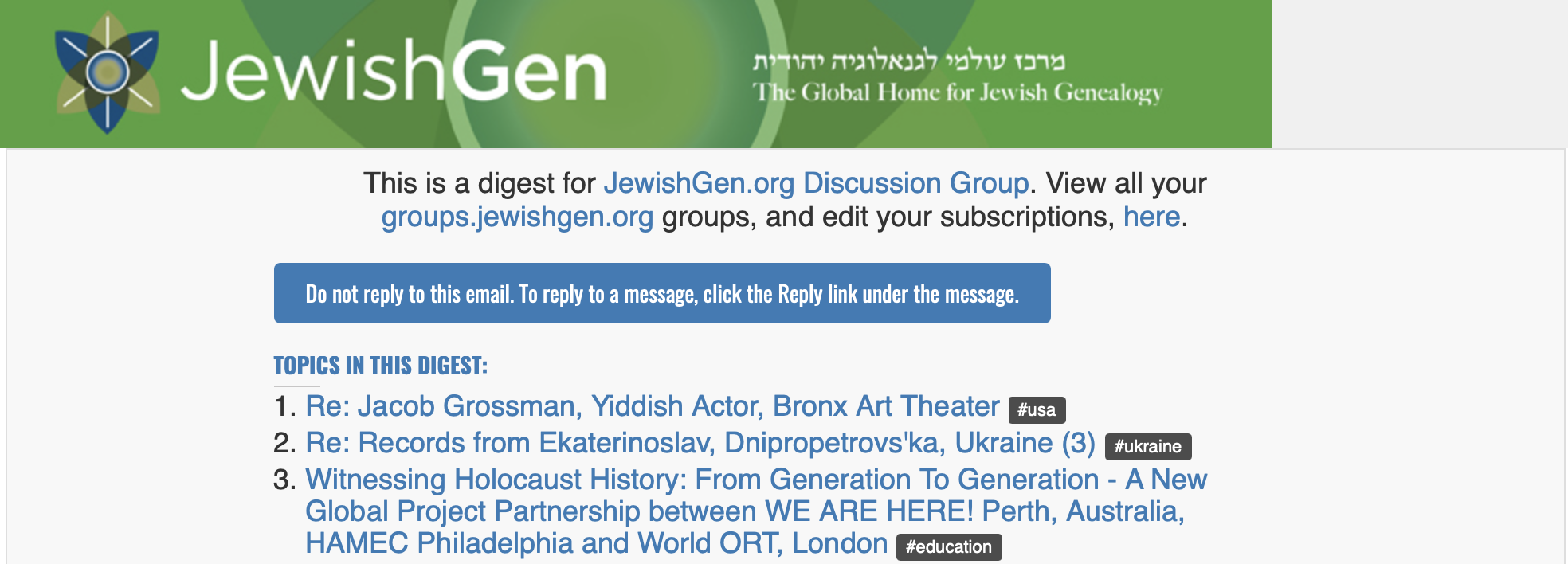
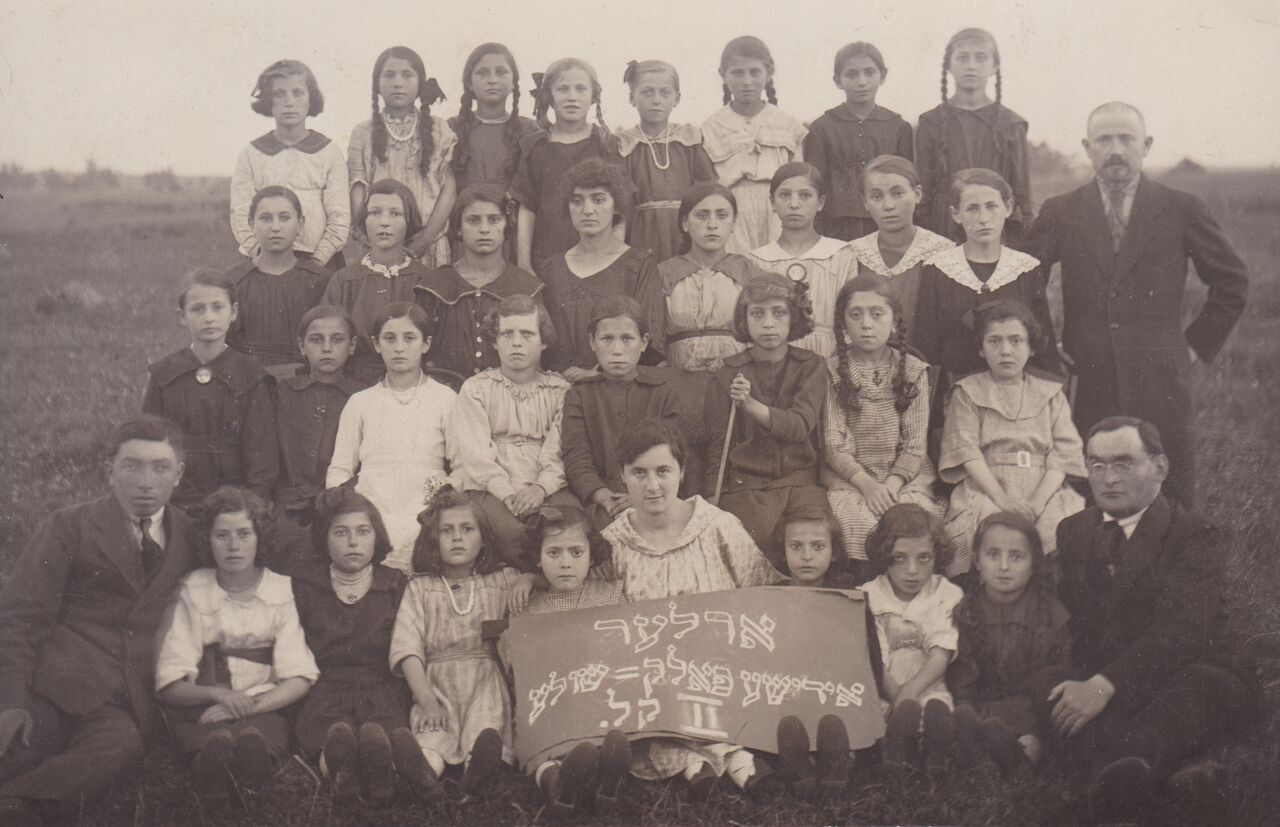

Perth, Australia
This global program will start with 19 ORT schools on 27 January 2021, and will continue with more schools for Yom Hashoah through 8/9 April 2021
Website:
https://wah.foundation/witnessing-holocaust-history-from-generation-to-generation/
Press Statement from HAMEC:
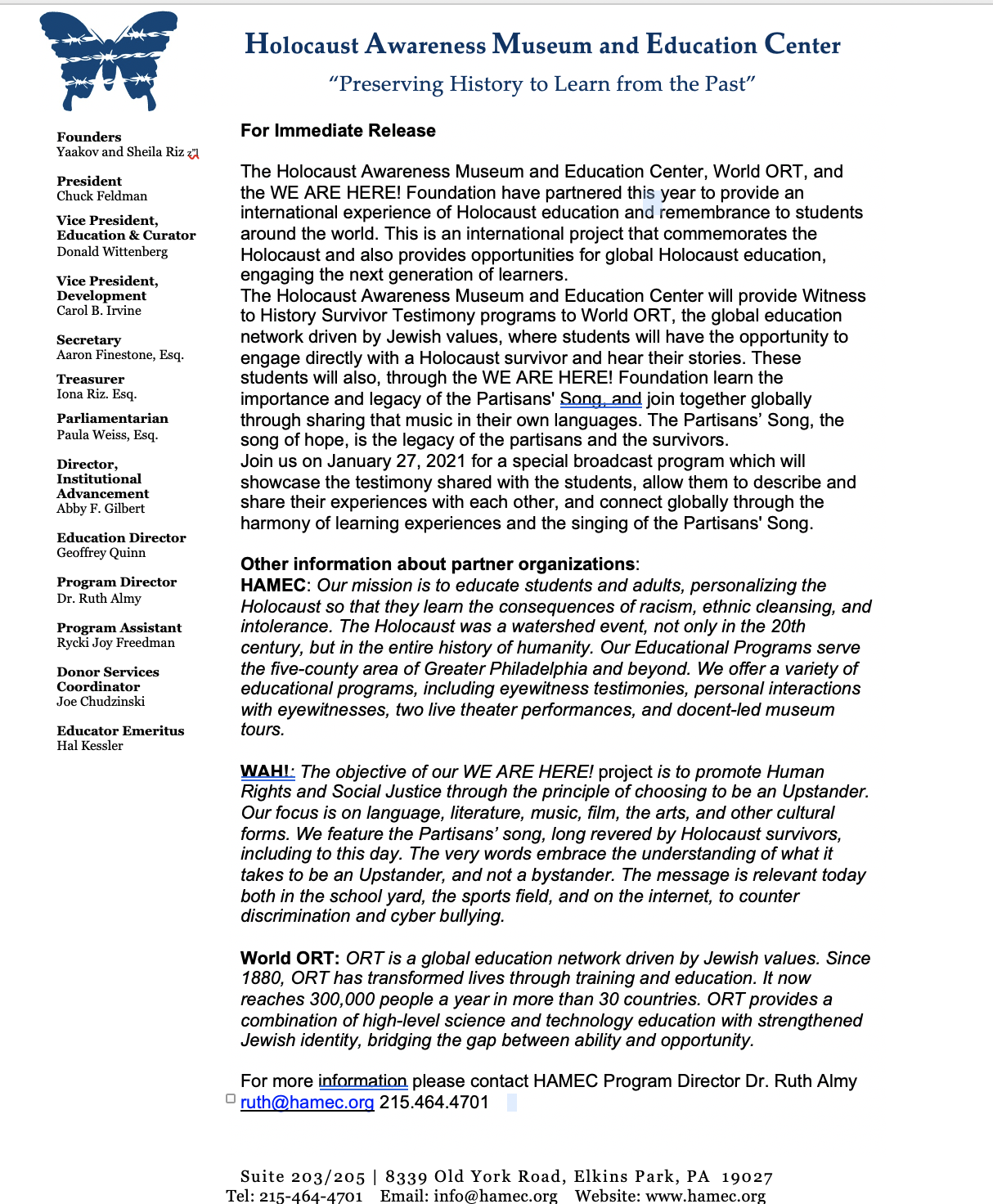

HAMEC ORT WAH! Ruth Almy Intro 27 January 2021
Source: youtu.be/Fqm3R-h6RPE
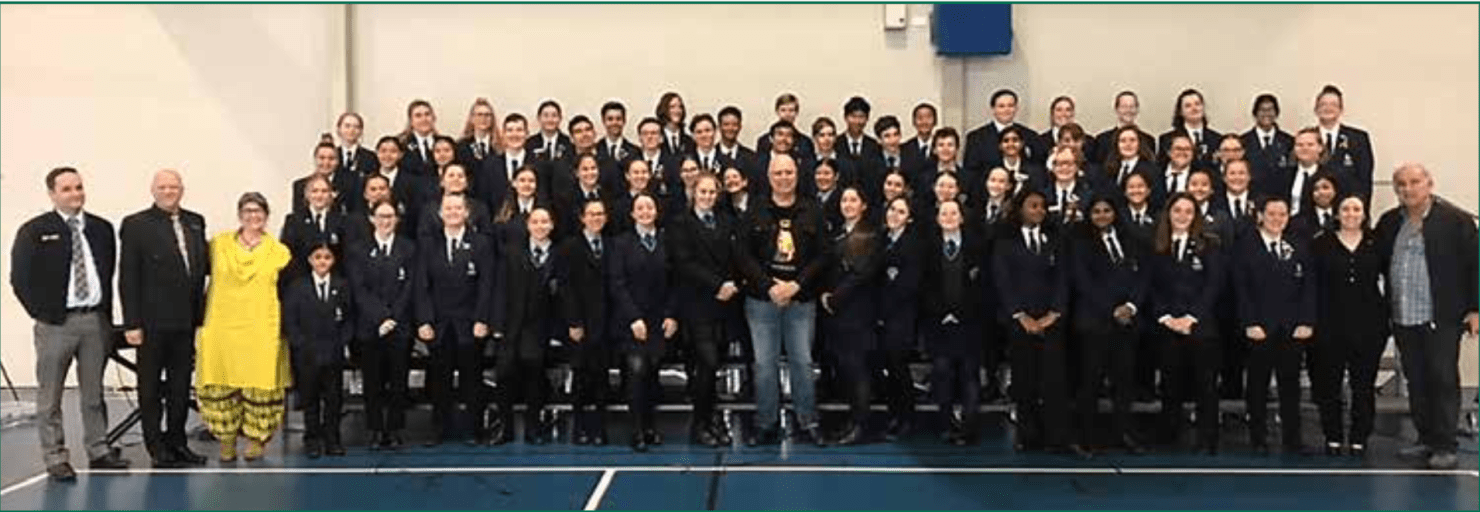
Participating ORT Schools for the 27 January 2021 event are:
| Country/ City | Timezone | School |
| Mexico/ Mexico City | CST | CIM-ORT |
| South Africa/ Cape Town | SAST | Herzlia |
| South Africa/Johannesburg | SAST | King David Victory Park High |
| Bulgaria/Sofia | EEST | Dimcho Debelianov Hebrew and English Language School |
| Netherlands/ Amsterdam | CET | JSG Maimonides |
| Spain/Madrid | CET | ORT Colegio Estrella Toledano |
| Russia/ St Petersburg | MST | ORT de Gunzburg Secondary School # 550 “Shorashim” |
| Russia/ Samara | SST | Samara ORT Secondary School# 42, “Gesher” |
| Russia/ Moscow | MST | ORT Tekhiya, Center of Education # 1311 |
| Russia/Moscow | MST | ORT Moscow Technology School, Gymnasium # 1540 |
| Russia/ Kazan | MST | ORT “Mishpahteinu” Secondary School # 12 |
| Ukraine/ Chernivtsi | EEST | ORT Specialized School #41 |
| Ukraine/ Kiev | EEST | Kiev ORT Educational Complex #141 |
| Ukraine/ Odessa | EEST | ORT Secondary School # 94 |
| Ukraine/ Zhaporozhie | EEST | ORT “Aleph” Jewish Gymnasium |
| Moldova/ Kishinev | EEST | ORT Technology Lyceum |
| Estonia/ Tallinn | EEST | ORT Tallinn Jewish School |
| Latvia/ Riga | EEST | ORT Network Jewish Secondary School |
| Lithuania/ Vilnius | EEST | Vilnius Sholom Aleichem ORT School |
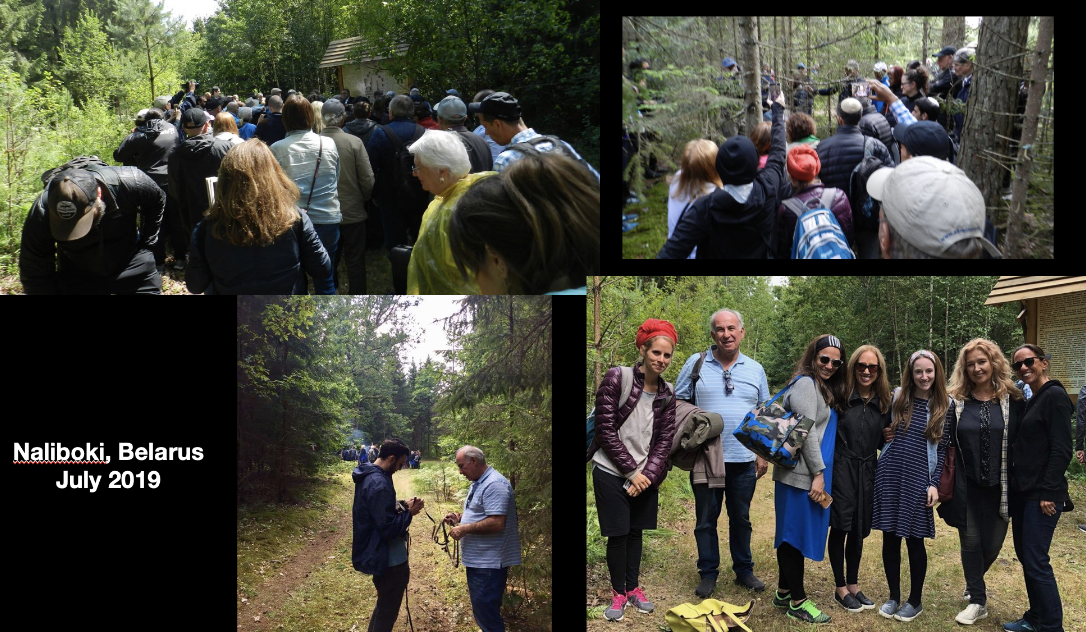
Bielski Reunion, Belarus

For more info about this post, contact Eli Rabinowitz eli@elirab.com

Ellenbrook Secondary College & Carmel High SchoolAt Ellenbrook Secondary College5 August 2019
Source: youtu.be/iIJ-rC-DcWA
